What we’re thinking
We’re breaking free of the historical view of value. Fixing growth blind spots and the innovation problem.
Once you free your mind about a concept of harmony and of music being correct you can do whatever you want
Giorgio Moroder
Channeling Giorgio Moroder: Once we free our minds about the traditional concept of manufacturers embedding value and exchanging it for cash (value-in-exchange), we observe value-through-progress. Where seekers realise maximum value upon reaching their progress sought (after seeing only potential value at their progress origin). It naturally follows that value really emerges, incrementally, as progress is made.
This has profound implications: we see value as a trailing measure of progress; it is co-created during progress attempts; progress seekers predominantly judge value (potential progress, progress reached); and innovation gets a clear focus of improving progress (from which increased value emerges).
However, for emerged value to be meaningful to a progress seeker, they need to recognise it. Value recognition is a process akin to accountants recognising revenue. Often this recognition runs on a different schedule to emergence.
Finally, if progress is hampered or not as expected, we might experience value destruction.
Introducing Value models
Let’s explore value. It’s a fundamental driver of how we perceive the world around us. Where our understanding shapes our beliefs about who creates it, how, and when. And that has far-reaching implications for how we approach, and succeed with, innovation.
If I was to guess your current view of value, I imagine it follows the traditional view. That is to say value maps to the maximum amount of cash you’ll pay for something. You’d be aligned with most people’s thinking as well as the teaching in economics and business classes from school, through universities and onto business schools. But this model has blind spots that challenge future growth and innovation.
We’ll explore three models:
- value-in-exchange – our traditional model and aligning with goods-dominant logic
- value-in-use – from service-forwards logics
- value-through-progress – the basis of the progress economy
Each model offers solutions to the challenges of its predecessor.
| value | -in-exchange | -in-use | -through-progress |
|---|---|---|---|
| defined as… | …most a customer will pay | …increase in beneficiary well-being | …potential to, and emerges from, reaching progress sought from a seeker’s current progress origin (progress states comprise: functional, non-functional, contextual elements) |
| measured through | * price | * well-being (which may require objective scales applied to subjective aspects) | * progress potential * progress reached * progress offered |
| determined by | * firm * can argue subsequently by market judgement of price | * beneficiary | * predominantly the progress seeker * in some cases the progress helper (ie initially making resources available; subsequently withdrawing resources if value destruction occurs due to seeker) |
| created by | * firm through embedding it in products | * co-created by all actors including the beneficiary during the use of value proposition | * emerges as progress seeker makes progress – on their own or with a progress proposition – progress-making activities may be driven by seeker, helper, or a combination * emerged value needs to be recognised by progress seeker – a process akin to revenue recognition – in order to be meaningful |
| resource focus | * operand (those that need acting upon for value to be created) | * operant (those that act upon other resources resulting in value creation) | * operant |
| actor focus | * firm | * beneficiary | * progress seeker |
| innovation aims to… | * get higher price in exchange by embedding more value * get more exchanges through lowering price | * improve well-being (beneficiary and/or service system) | * improve progress through some combination of: – improving how to make today’s progress – improving progress potential closer to individual seeker’s progress sought – reducing one or more of 6 progress hurdles – improving value recognition without impacting survivability of progress helper(s) |
| challenges | weak definition |
We’ll find that a focus on value is what hinders our future growth and challenges our innovation activities. Instead, we need to focus on progress – which is much more actionable and measurable. And that value emerges from making progress.
Our journey will see us evolve our view of value as relating to the following:
price » well-being » progress
Let’s start with value-in-exchange.
Exchanging value (value-in-exchange)
You’ll likely recognise the traditional value-in-exchange model:
value-in-exchange
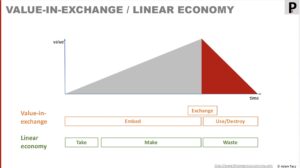
Our traditional model which has historically been wildly successful.
- It revolves around manufacturers embedding value into products and exchanging them for other valuable items, typically cash (it’s the basis of goods-dominant logic).
- We try and force services into the same model, though find them poor relatives: intangible, inconsistent, require involvement, can’t create inventories and production/consumption are inseparable.
- Our innovation mentality is about creating/adding value. Increasing the customers incentive to buy (hopefully resulting in either increased price per exchange, increased number of exchanges, or both).
Historically, this model has been wildly successful. However, the model has inherent blind spots – before, after, and across the point of exchange, drives a goods vs service mentality, and encourages a non-circular economy mindset.
Additionally, defining value is challenging. How many of your innovation activities truly manage to add value? Are you in the 94% of executives that McKinsey found were unhappy with innovation activities (see “our innovation problem”)?
All the above ultimately hinder future growth.
Using propositions (value-in-use)
With the value-in-use model, we address most of the value-in-exchange blindspots. It starts with the observation that value is only created when using value propositions (ie it is not embedded and exchanged by manufacturers).
- The model removes the problematic point of exchange, helping us minimise the related blind spots.
- Everything is a service: the application of skills and knowledge for the benefit of others, or oneself (as in service-forward logics, such as service-logic and service-dominant logic)
- Additionally we’ll find goods are distribution mechanisms for service. Removing the unhelpful divisions between goods and services.
- Value, in this model, measures the increase in wellbeing of a system, including the beneficiary
- Now we innovate to make propositions more useful and increase system wellbeing.
value-in-use
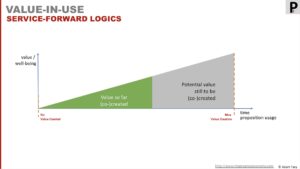
Minimising the blind spots of value-in-exchange by removing the deep focus on a point of exchange.
Despite these advances, defining and understanding value (or usefulness/wellbeing) in actionable terms remains a challenge. We also lose the definition of price – which previously was a measure of value – and certainly is there in the real world.
Making progress (value-through-progress)
It turns out that making progress is what we’re trying to make in life, and progress is much more actionable and measurable than value. Welcome to the value-through-progress model.
value-through-progress
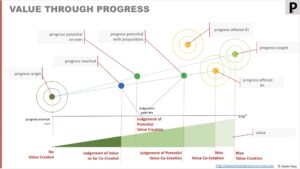
Defining value in an actionable way – or more correctly, realising value emerges from making progress.
- We build upon the value-in-use model, inheriting its advantages over value-in-exchange.
- Our focus shifts to understanding progress – moving to a more desirable state. What is sought? Where are we starting from? Where are others offering to help us reach?
- “Value” naturally emerges as a trailing metric of progress reached (towards that more desired state).
- “Value” is also a prediction of potential progress that could be made (by both seeker and helper).
- Innovation becomes the actionable process of finding ways to make better functional and non-functional progress within a defined context; reducing one or more of the six hurdles to progress; or altering how/when seekers make various defined progress decisions.
I firmly believe that the value-through-progress model is the future of fostering innovation and driving future growth – hence the concept of the progress economy.
Though there is one more aspect of value in the progress economy to uncover – value emergence vs value recognition.
Recognising emerged value
How much value is there in reaching c c 80km today of a 100km journey? Well, value emerges as progress is made, so s ome value has emerged. But is that value meaningful to the seeker? That depends.
To a seeker that can rest overnight and continue the final 20km tomorrow, there is meaningful value. For a seeker that needed to arrive at the 100km point by a set time today, there is no meaningful value; the attempt has been a waste of resources (at least time). In the progress economy:
- Value emerges as progress is made
- But it needs to be recognised by a seeker for it to be meaningful to them
- Value recognition is a process akin to revenue recognition used in organisations
- Emergence and recognition do not have to happen on the same timeframes
- Another aspect of innovation emerges: helping change the seekers value recognition timeframes.
value recognition
Value needs recognising – akin to revenue recognition – for it to be meaningful
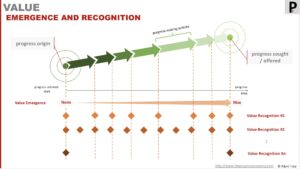
So, are you ready to explore the fascinating world of value and progress? I suggest starting with the traditional view – value-in-exchange – and see how it works, its benefits and why it ultimately is now hindering innovation, growth, and the circular economy.
Then move on to value-in-use to see how that addresses the value-in-exchange blind spots. Before delving into our progress economy’s value-in-progress model to see how that unlocks growth and systematic innovation.
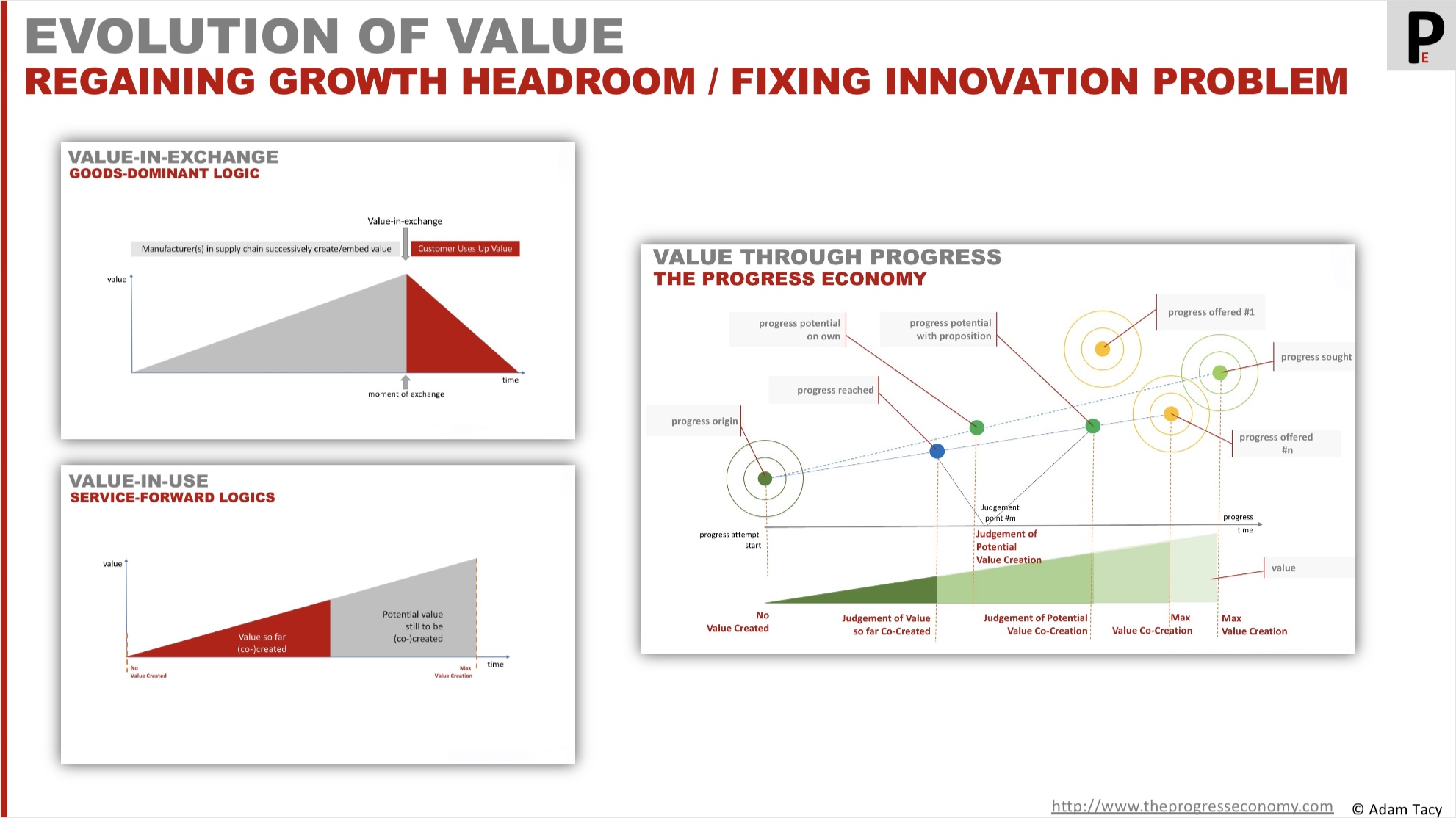
Let’s progress together through discussion…